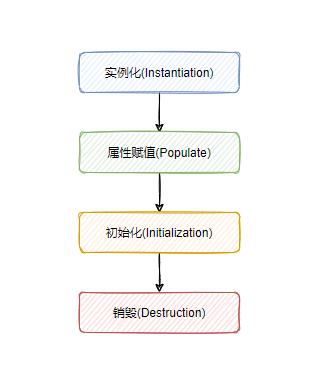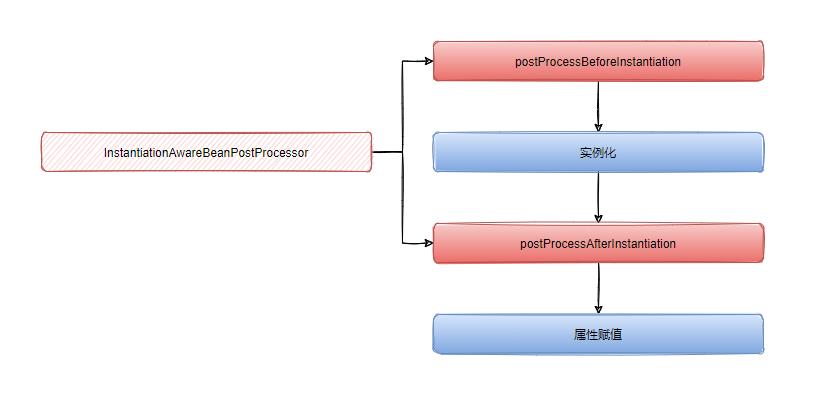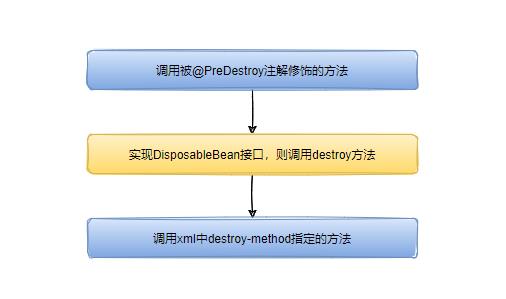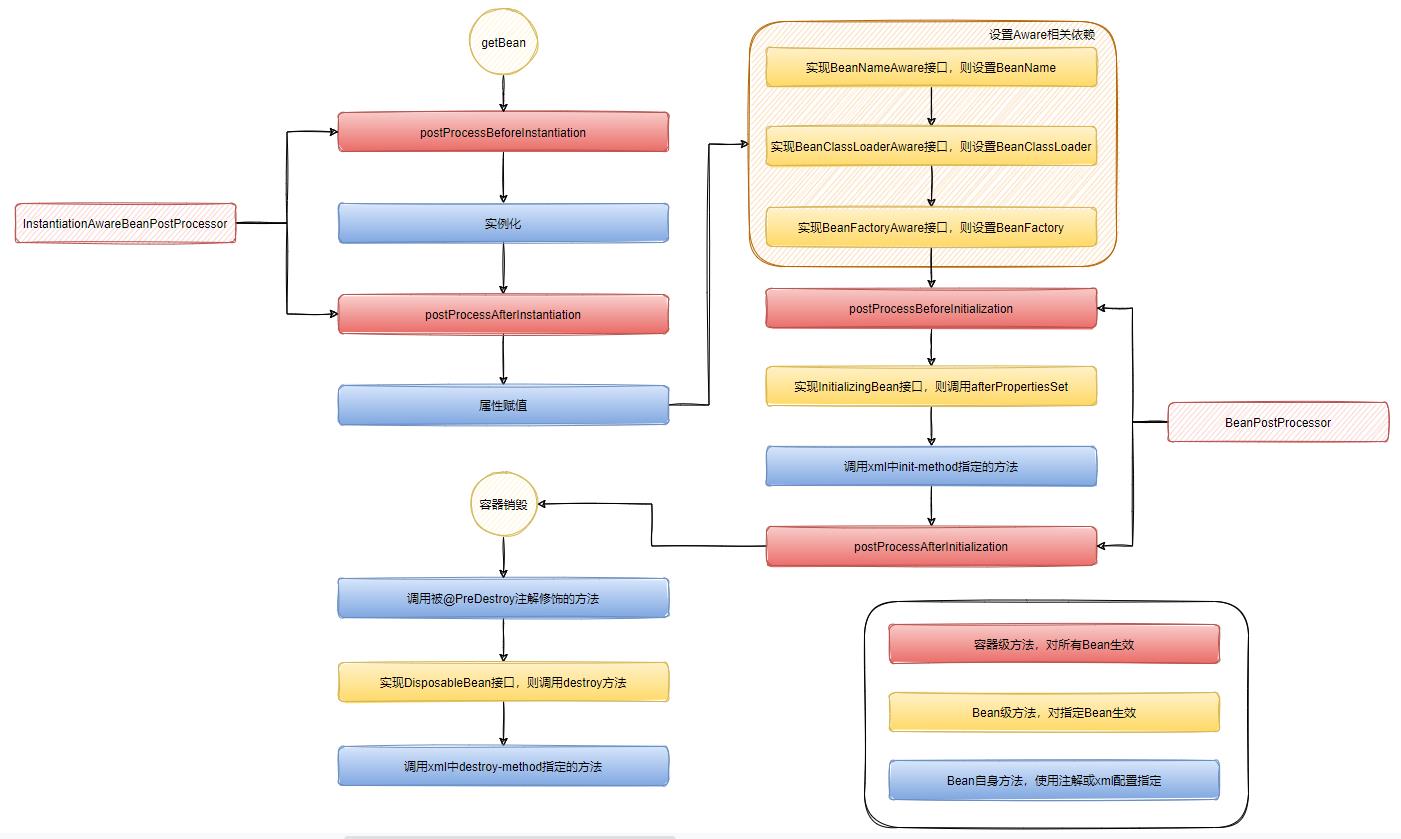咋还记不住常见 ogf
Posted do_while_true
tags:
篇首语:本文由小常识网(cha138.com)小编为大家整理,主要介绍了咋还记不住常见 ogf相关的知识,希望对你有一定的参考价值。
第一个的记忆:\\(<1,-1>\\) 是 \\(1-x\\),然后奇偶位置分别作前缀和,那就是 \\(\\frac1-x1-x^2=\\frac11+x\\).
第二个的记忆:右推左经典前缀和转格路计数,左推右是上指标反转成:
然后广义二项式定理。
cftm 一言切中了肯綮,套路是上下指标差恒等,利用上指标反转,这样上指标就是定值了。
还记不住Spring Bean的生命周期?看这篇你就知道方法了!
一、前言
上次我们在手把手教你解决循环依赖,一步一步地来窥探出三级缓存的奥秘中分析了Spring解决循环依赖的方式,在第6节中的doCreateBean(AbstractAutowireCapableBeanFactory类中)其实已经隐约看到了Bean的生命周期的几个阶段。
protected Object doCreateBean(final String beanName, final RootBeanDefinition mbd, final @Nullable Object[] args)
throws BeanCreationException {
//实例化bean
BeanWrapper instanceWrapper = createBeanInstance(beanName, mbd, args);
boolean earlySingletonExposure = (mbd.isSingleton() && this.allowCircularReferences &&
isSingletonCurrentlyInCreation(beanName));
if (earlySingletonExposure) {
//加入到三级缓存中,getEarlyBeanReference会返回单例工厂
addSingletonFactory(beanName, () -> getEarlyBeanReference(beanName, mbd, bean));
}
Object exposedObject = bean;
//属性赋值
populateBean(beanName, mbd, instanceWrapper);
//初始化
exposedObject = initializeBean(beanName, exposedObject, mbd);
if (earlySingletonExposure) {
//从二级缓存中查找
Object earlySingletonReference = getSingleton(beanName, false);
if (earlySingletonReference != null) {
//返回二级缓存中的bean,这里就有可能是代理后的对象
exposedObject = earlySingletonReference;
}
}
//销毁前的准备,注册待销毁的Bean
registerDisposableBeanIfNecessary(beanName, bean, mbd);
return exposedObject;
}doCreateBean基本描述了Bean生命周期的大致框架——实例化、属性赋值与初始化,当然Bean最后一步就是销毁。
基本阶段图

请记住这张图,也许你等会儿就不认识它了。
二、实例化与属性赋值阶段
当容器启动时,会依据配置或注解扫描指定的包,将其中的类转化为BeanDefinition,并集中在DefaultListableBeanFactory类的beanDefinitionMap变量里。
Spring中的BeanDdfinition,可以用来描述一个bean的作用域、是否懒加载、是否单例等。
容器启动完成后,当我们试图从容器获取一个Bean时,第一步就是去实例化该Bean。说白了,就是需要调用构造方法。
注意到在调用doCreateBean之前,调用了resolveBeforeInstantiation方法。
1、resolveBeforeInstantiation
protected Object createBean(String beanName, RootBeanDefinition mbd, @Nullable Object[] args)
throws BeanCreationException {
//省略部分代码
Object bean = resolveBeforeInstantiation(beanName, mbdToUse);
if (bean != null) {
return bean;
}
//正式进入生命周期
Object beanInstance = doCreateBean(beanName, mbdToUse, args);
return beanInstance;
}
protected Object resolveBeforeInstantiation(String beanName, RootBeanDefinition mbd) {
Object bean = null;
if (!Boolean.FALSE.equals(mbd.beforeInstantiationResolved)) {
if (!mbd.isSynthetic() && hasInstantiationAwareBeanPostProcessors()) {
Class<?> targetType = determineTargetType(beanName, mbd);
if (targetType != null) {
//寻找InstantiationAwareBeanPostProcessor,并执行相应方法
bean = applyBeanPostProcessorsBeforeInstantiation(targetType, beanName);
//在返回不为null的情况下,寻找BeanPostProcessor,执行相应方法
if (bean != null) {
bean = applyBeanPostProcessorsAfterInitialization(bean, beanName);
}
}
}
mbd.beforeInstantiationResolved = (bean != null);
}
return bean;
}当resolveBeforeInstantiation返回不为null的bean后,createBean会直接返回。也就是说,后续的实例化、属性赋值与初始化阶段都不会进行。这一步,将会给BeanPostProcessor一个返回代理而不是目前bean的机会。
resolveBeforeInstantiation核心的方法如下:
protected Object applyBeanPostProcessorsBeforeInstantiation(Class<?> beanClass, String beanName) {
//获取所有BeanPostProcessor的实现类
for (BeanPostProcessor bp : getBeanPostProcessors()) {
//如果属于InstantiationAwareBeanPostProcessor类型,则执行postProcessBeforeInstantiation方法
if (bp instanceof InstantiationAwareBeanPostProcessor) {
InstantiationAwareBeanPostProcessor ibp = (InstantiationAwareBeanPostProcessor) bp;
Object result = ibp.postProcessBeforeInstantiation(beanClass, beanName);
if (result != null) {
return result;
}
}
}
return null;
}
public Object applyBeanPostProcessorsAfterInitialization(Object existingBean, String beanName)
throws BeansException {
Object result = existingBean;
//获取所有BeanPostProcessor的实现类
for (BeanPostProcessor processor : getBeanPostProcessors()) {
//挨个执行postProcessAfterInitialization方法
Object current = processor.postProcessAfterInitialization(result, beanName);
if (current == null) {
return result;
}
result = current;
}
return result;
}2、BeanPostProcessor
BeanPostProcessor是容器提供给我们的一个扩展接口,也称Bean的后置处理器。我们可以实现该接口,用来添加业务中特有的逻辑。
BeanPostProcessor实现类也是一个普通的Bean,那么Spring是怎么保证BeanPostProcessor实现类在开发人员写的Bean之前加载的呢?
这就要回到我们最熟悉的refresh方法中
public void refresh() {
// Prepare this context for refreshing.
prepareRefresh();
// Tell the subclass to refresh the internal bean factory.
ConfigurableListableBeanFactory beanFactory = obtainFreshBeanFactory();
// Prepare the bean factory for use in this context.
prepareBeanFactory(beanFactory);
// Allows post-processing of the bean factory in context subclasses.
postProcessBeanFactory(beanFactory);
// Invoke factory processors registered as beans in the context.
invokeBeanFactoryPostProcessors(beanFactory);
// Register bean processors that intercept bean creation.
registerBeanPostProcessors(beanFactory);
// Initialize message source for this context.
initMessageSource();
// Initialize event multicaster for this context.
initApplicationEventMulticaster();
// Initialize other special beans in specific context subclasses.
onRefresh();
// Check for listener beans and register them.
registerListeners();
// Instantiate all remaining (non-lazy-init) singletons.
finishBeanFactoryInitialization(beanFactory);
// Last step: publish corresponding event.
finishRefresh();
}其中registerBeanPostProcessors方法就会对BeanPostProcessor进行注册,在finishBeanFactoryInitialization中再完成非懒加载的单例Bean的加载。
从而BeanPostProcessor就会在业务Bean之前加载,因此可以在业务Bean实例化前进行调用。
3、instantiateBean
现在可以进入doCreateBean中,createBeanInstance包含了实例化bean并封装为BeanWrapper的逻辑,且内部提供了多种实例化的方式。
protected BeanWrapper createBeanInstance(String beanName, RootBeanDefinition mbd, @Nullable Object[] args) {
//将bean转化为class对象
Class<?> beanClass = resolveBeanClass(mbd, beanName);
//基于Supplier实例化
Supplier<?> instanceSupplier = mbd.getInstanceSupplier();
if (instanceSupplier != null) {
return obtainFromSupplier(instanceSupplier, beanName);
}
//基于工厂方法实例化
if (mbd.getFactoryMethodName() != null) {
return instantiateUsingFactoryMethod(beanName, mbd, args);
}
//省略部分代码
//基于有参构造函数实例化
Constructor<?>[] ctors = determineConstructorsFromBeanPostProcessors(beanClass, beanName);
if (ctors != null || mbd.getResolvedAutowireMode() == AUTOWIRE_CONSTRUCTOR ||
mbd.hasConstructorArgumentValues() || !ObjectUtils.isEmpty(args)) {
return autowireConstructor(beanName, mbd, ctors, args);
}
//基于无参构造函数实例化
return instantiateBean(beanName, mbd);
}有兴趣的同学,可以深入到这几种方式的内部,这里就不做探讨了。
4、populateBean
在实例化结束后,将进入属性赋值阶段。
protected void populateBean(String beanName, RootBeanDefinition mbd, @Nullable BeanWrapper bw) {
boolean continueWithPropertyPopulation = true;
if (!mbd.isSynthetic() && hasInstantiationAwareBeanPostProcessors()) {
for (BeanPostProcessor bp : getBeanPostProcessors()) {
//如果属于InstantiationAwareBeanPostProcessor类型,则调用postProcessAfterInstantiation
if (bp instanceof InstantiationAwareBeanPostProcessor) {
InstantiationAwareBeanPostProcessor ibp = (InstantiationAwareBeanPostProcessor) bp;
if (!ibp.postProcessAfterInstantiation(bw.getWrappedInstance(), beanName)) {
continueWithPropertyPopulation = false;
break;
}
}
}
}
//一旦任意一个InstantiationAwareBeanPostProcessor的postProcessAfterInstantiation返回false,属性注入阶段将不再进行,直接进入下一个阶段
if (!continueWithPropertyPopulation) {
return;
}
PropertyValues pvs = (mbd.hasPropertyValues() ? mbd.getPropertyValues() : null);
if (mbd.getResolvedAutowireMode() == AUTOWIRE_BY_NAME || mbd.getResolvedAutowireMode() == AUTOWIRE_BY_TYPE) {
MutablePropertyValues newPvs = new MutablePropertyValues(pvs);
//按照名称注入
if (mbd.getResolvedAutowireMode() == AUTOWIRE_BY_NAME) {
autowireByName(beanName, mbd, bw, newPvs);
}
//按照类型注入
if (mbd.getResolvedAutowireMode() == AUTOWIRE_BY_TYPE) {
autowireByType(beanName, mbd, bw, newPvs);
}
pvs = newPvs;
}
//省略掉InstantiationAwareBeanPostProcessor其他两个扩展点及下面的依赖检查
if (pvs != null) {
//属性注入
applyPropertyValues(beanName, mbd, bw, pvs);
}
}到这里,实例化与属性赋值阶段结束,我们整理一下其中的扩展点

三、初始化阶段
从doCreateBean内的initializeBean开始
protected Object initializeBean(final String beanName, final Object bean, @Nullable RootBeanDefinition mbd) {
//1.设置Aware相关依赖
if (System.getSecurityManager() != null) {
AccessController.doPrivileged((PrivilegedAction<Object>) () -> {
invokeAwareMethods(beanName, bean);
return null;
}, getAccessControlContext());
}
else {
invokeAwareMethods(beanName, bean);
}
//2.调用BeanPostProcessor的前置处理
Object wrappedBean = bean;
if (mbd == null || !mbd.isSynthetic()) {
wrappedBean = applyBeanPostProcessorsBeforeInitialization(wrappedBean, beanName);
}
//3.1调用InitializingBean的afterPropertiesSet方法
//3.2调用自定义的init method方法
try {
invokeInitMethods(beanName, wrappedBean, mbd);
}
catch (Throwable ex) {
throw new BeanCreationException(
(mbd != null ? mbd.getResourceDescription() : null),
beanName, "Invocation of init method failed", ex);
}
//4.调用BeanPostProcessor的后置处理
if (mbd == null || !mbd.isSynthetic()) {
wrappedBean = applyBeanPostProcessorsAfterInitialization(wrappedBean, beanName);
}
return wrappedBean;
}1、设置Aware相关依赖
private void invokeAwareMethods(final String beanName, final Object bean) {
if (bean instanceof Aware) {
//如果bean实现了BeanNameAware接口,则设置BeanName
if (bean instanceof BeanNameAware) {
((BeanNameAware) bean).setBeanName(beanName);
}
//如果bean实现了BeanClassLoaderAware接口,则设置BeanClassLoader
if (bean instanceof BeanClassLoaderAware) {
ClassLoader bcl = getBeanClassLoader();
if (bcl != null) {
((BeanClassLoaderAware) bean).setBeanClassLoader(bcl);
}
}
//如果bean实现了BeanFactoryAware接口,则设置BeanFactory
if (bean instanceof BeanFactoryAware) {
((BeanFactoryAware) bean).setBeanFactory(AbstractAutowireCapableBeanFactory.this);
}
}
}从这里可以看出,只要Bean实现了指定的Aware接口,Spring就会向Bean注入这些Aware相关信息。
2、调用BeanPostProcessor的前置处理
public Object applyBeanPostProcessorsBeforeInitialization(Object existingBean, String beanName)
throws BeansException {
Object result = existingBean;
//获取所有BeanPostProcessor的实现类
for (BeanPostProcessor processor : getBeanPostProcessors()) {
//挨个调用postProcessBeforeInitialization方法
Object current = processor.postProcessBeforeInitialization(result, beanName);
if (current == null) {
return result;
}
result = current;
}
return result;
}这一步会获取容器中所有BeanPostProcessor的实现类,挨个调用postProcessBeforeInitialization方法。在其返回不为null的情况下,后一个结果会覆盖上一个结果。
当然在处理到ApplicationContextAwareProcessor的时候,会设置以下Aware依赖。
- EnvironmentAware
- EmbeddedValueResolverAware
- ResourceLoaderAware
- ApplicationEventPublisherAware
- MessageSourceAware
- ApplicationContextAware
在处理到InitDestroyAnnotationBeanPostProcessor,会找出被@PostConstruct注解修饰的方法,并执行。
3、invokeInitMethods
protected void invokeInitMethods(String beanName, final Object bean, @Nullable RootBeanDefinition mbd)
throws Throwable {
//如果实现了InitializingBean接口,则调用afterPropertiesSet方法
boolean isInitializingBean = (bean instanceof InitializingBean);
if (isInitializingBean && (mbd == null || !mbd.isExternallyManagedInitMethod("afterPropertiesSet"))) {
if (logger.isTraceEnabled()) {
logger.trace("Invoking afterPropertiesSet() on bean with name '" + beanName + "'");
}
if (System.getSecurityManager() != null) {
try {
AccessController.doPrivileged((PrivilegedExceptionAction<Object>) () -> {
((InitializingBean) bean).afterPropertiesSet();
return null;
}, getAccessControlContext());
}
catch (PrivilegedActionException pae) {
throw pae.getException();
}
}
else {
((InitializingBean) bean).afterPropertiesSet();
}
}
//调用xml中声明的init-method指定的方法
if (mbd != null && bean.getClass() != NullBean.class) {
String initMethodName = mbd.getInitMethodName();
if (StringUtils.hasLength(initMethodName) &&
!(isInitializingBean && "afterPropertiesSet".equals(initMethodName)) &&
!mbd.isExternallyManagedInitMethod(initMethodName)) {
invokeCustomInitMethod(beanName, bean, mbd);
}
}
}4、调用BeanPostProcessor的后置处理
和前置处理类似,只是调用postProcessAfterInitialization方法,不再赘述。
因此,初始化过程又可以被细分为

四、销毁阶段
在容器关闭的时候,会进入Bean的销毁阶段,代码从AbstractApplicationContext的close()方法开始
不急着进入close()方法,先看一下第一节代码中最末尾的方法:
protected void registerDisposableBeanIfNecessary(String beanName, Object bean, RootBeanDefinition mbd) {
AccessControlContext acc = (System.getSecurityManager() != null ? getAccessControlContext() : null);
//如果Bean不是多例且需要在容器关闭时销毁
if (!mbd.isPrototype() && requiresDestruction(bean, mbd)) {
if (mbd.isSingleton()) {
//给当前Bean绑定一个DisposableBeanAdapter
registerDisposableBean(beanName,
new DisposableBeanAdapter(bean, beanName, mbd, getBeanPostProcessors(), acc));
}
else {
// A bean with a custom scope...
Scope scope = this.scopes.get(mbd.getScope());
if (scope == null) {
throw new IllegalStateException("No Scope registered for scope name '" + mbd.getScope() + "'");
}
scope.registerDestructionCallback(beanName,
new DisposableBeanAdapter(bean, beanName, mbd, getBeanPostProcessors(), acc));
}
}
}
public void registerDisposableBean(String beanName, DisposableBean bean) {
synchronized (this.disposableBeans) {
this.disposableBeans.put(beanName, bean);
}
}在registerDisposableBeanIfNecessary中,会对每一个需要在容器关闭时进行销毁的单例Bean,绑定对应的DisposableBeanAdapter对象。最后把这些Bean及其DisposableBeanAdapter放入进名称为disposableBeans的map中,以供后续使用。
现在我们进入AbstractApplicationContext的close()方法
一路上兜兜转转,会进入到DefaultSingletonBeanRegistry的destroySingletons方法中
public void destroySingletons() {
String[] disposableBeanNames = StringUtils.toStringArray(this.disposableBeans.keySet());
for (int i = disposableBeanNames.length - 1; i >= 0; i--) {
destroySingleton(disposableBeanNames[i]);
}
//省略部分代码
}先拿到所有待销毁Bean的名称,挨个调用destroySingleton方法,一直往下走,最终会进入到DefaultSingletonBeanRegistry的destroyBean中
其中核心的一句
// Actually destroy the bean now...
bean.destroy();
按照beanName从disposableBeans中获取到bean对应的DisposableBeanAdapter,调用其destroy方法
public void destroy() {
//调用被@PreDestroy注解修饰的方法
//具体可以跟进InitDestroyAnnotationBeanPostProcessor类
if (!CollectionUtils.isEmpty(this.beanPostProcessors)) {
for (DestructionAwareBeanPostProcessor processor : this.beanPostProcessors) {
processor.postProcessBeforeDestruction(this.bean, this.beanName);
}
}
//如果实现了DisposableBean接口,则调用destroy方法
if (this.invokeDisposableBean) {
if (System.getSecurityManager() != null) {
AccessController.doPrivileged((PrivilegedExceptionAction<Object>) () -> {
((DisposableBean) this.bean).destroy();
return null;
}, this.acc);
} else {
((DisposableBean) this.bean).destroy();
}
}
//调用xml中自定义的destroy-method方法
if (this.destroyMethod != null) {
invokeCustomDestroyMethod(this.destroyMethod);
} else if (this.destroyMethodName != null) {
Method methodToCall = determineDestroyMethod(this.destroyMethodName);
if (methodToCall != null) {
invokeCustomDestroyMethod(methodToCall);
}
}
}到这里,Bean的销毁过程基本就结束了,我们使用一张图来概括下:

五、生命周期的全流程
我们整个阶段串联起来

六、代码验证
待观察的Bean
public class A implements BeanNameAware, BeanClassLoaderAware, BeanFactoryAware, InitializingBean, DisposableBean {
private int id;
public int getId() {
return id;
}
public void setId(int id) {
this.id = id;
System.out.println("属性赋值");
}
private A() {
System.out.println("实例化");
}
@PostConstruct
public void postConstruct() {
System.out.println("@PostConstruct指定的方法");
}
@Override
public void setBeanClassLoader(ClassLoader classLoader) {
System.out.println("BeanClassLoaderAware.setBeanClassLoader");
}
@Override
public void setBeanFactory(BeanFactory beanFactory) throws BeansException {
System.out.println("BeanFactoryAware.setBeanFactory");
}
@Override
public void setBeanName(String name) {
System.out.println("BeanNameAware.setBeanName");
}
@Override
public void afterPropertiesSet() {
System.out.println("InitializingBean.afterPropertiesSet");
}
public void initMethod() {
System.out.println("xml中init-method指定的方法");
}
@PreDestroy
public void preDestroy() {
System.out.println("@PreDestroy指定的方法");
}
@Override
public void destroy() {
System.out.println("DisposableBean.destroy");
}
public void destroyMethod() {
System.out.println("xml中destroy-method指定的方法");
}
}自定义的BeanPostProcessor
public class BeanPostProcessorImpl implements BeanPostProcessor {
@Override
public Object postProcessBeforeInitialization(Object bean, String beanName) throws BeansException {
if (beanName.equals("a")) {
System.out.println("BeanPostProcessor.postProcessBeforeInitialization");
}
return bean;
}
@Override
public Object postProcessAfterInitialization(Object bean, String beanName) throws BeansException {
if (beanName.equals("a")) {
System.out.println("BeanPostProcessor.postProcessAfterInitialization");
}
return bean;
}
}自定义的InstantiationAwareBeanPostProcessorImpl
public class InstantiationAwareBeanPostProcessorImpl implements InstantiationAwareBeanPostProcessor {
@Override
public Object postProcessBeforeInstantiation(Class<?> beanClass, String beanName) throws BeansException {
if (beanName.equals("a")) {
System.out.println("InstantiationAwareBeanPostProcessor.postProcessBeforeInstantiation");
}
return null;
}
@Override
public boolean postProcessAfterInstantiation(Object bean, String beanName) throws BeansException {
if (beanName.equals("a")) {
System.out.println("InstantiationAwareBeanPostProcessor.postProcessBeforeInstantiation");
}
//如果这里返回false,那么所有Bean将不进行属性赋值
return true;
}
}spring.xml配置
<?xml version="1.0" encoding="UTF-8"?>
<beans xmlns="http://www.springframework.org/schema/beans"
xmlns:xsi="http://www.w3.org/2001/XMLSchema-instance"
xmlns:context="http://www.springframework.org/schema/context"
xsi:schemaLocation="http://www.springframework.org/schema/beans
https://www.springframework.org/schema/beans/spring-beans.xsd http://www.springframework.org/schema/context http://www.springframework.org/schema/context/spring-context.xsd">
<context:component-scan base-package="com.yang.ym"/>
<bean id="a" class="com.yang.ym.testBean.A" init-method="initMethod" destroy-method="destroyMethod">
<property name="id" value="1"/>
</bean>
<bean class="com.yang.ym.testBean.BeanPostProcessorImpl"/>
<bean class="com.yang.ym.testBean.InstantiationAwareBeanPostProcessorImpl"/>
</beans>测试类
@Test
public void get() {
ClassPathXmlApplicationContext context = new ClassPathXmlApplicationContext("spring.xml");
A a = (A) context.getBean("a");
System.out.println("关闭容器");
context.close();
}输出结果:
InstantiationAwareBeanPostProcessor.postProcessBeforeInstantiation
实例化
InstantiationAwareBeanPostProcessor.postProcessBeforeInstantiation
属性赋值
BeanNameAware.setBeanName
BeanClassLoaderAware.setBeanClassLoader
BeanFactoryAware.setBeanFactory
BeanPostProcessor.postProcessBeforeInitialization
@PostConstruct指定的方法
InitializingBean.afterPropertiesSet
xml中init-method指定的方法
BeanPostProcessor.postProcessAfterInitialization
关闭容器
@PreDestroy指定的方法
DisposableBean.destroy
xml中destroy-method指定的方法七、总结
先记住4个大阶段,实例化、属性赋值、初始化与销毁。
在生命周期内部,可以自定义Bean后置处理器以及实现接口的形式来进行扩展
- 容器级的扩展点,InstantiationAwareBeanPostProcessor与BeanPostProcessor。
- Bean级的扩展点,Aware相关接口,InitializingBean与DisposableBean。
此外,可以使用注解或xml配置形式,指定扩展点
- @PostConstruct注解
- @PreDestroy注解
- xml中init-method
- xml中destroy-method
那么再记忆生命周期的先后顺序,就会容易很多:
getBean
- InstantiationAwareBeanPostProcessor.postProcessBeforeInstantiation
- 实例化
- InstantiationAwareBeanPostProcessor.postProcessBeforeInstantiation
- 属性赋值
- Aware接口回调
- BeanPostProcessor.postProcessBeforeInitialization
- @PostConstruct指定的方法
- InitializingBean.afterPropertiesSet
- xml中init-method指定的方法
- BeanPostProcessor.postProcessAfterInitialization
关闭容器后
- @PreDestroy指定的方法
- DisposableBean.destroy
- xml中destroy-method指定的方法
以上是关于咋还记不住常见 ogf的主要内容,如果未能解决你的问题,请参考以下文章
网络编程一如何记住OSI七层协议模型,看完还记不住的来打我。
CF960G - Bandit Blues(第一类斯特林数+OGF)